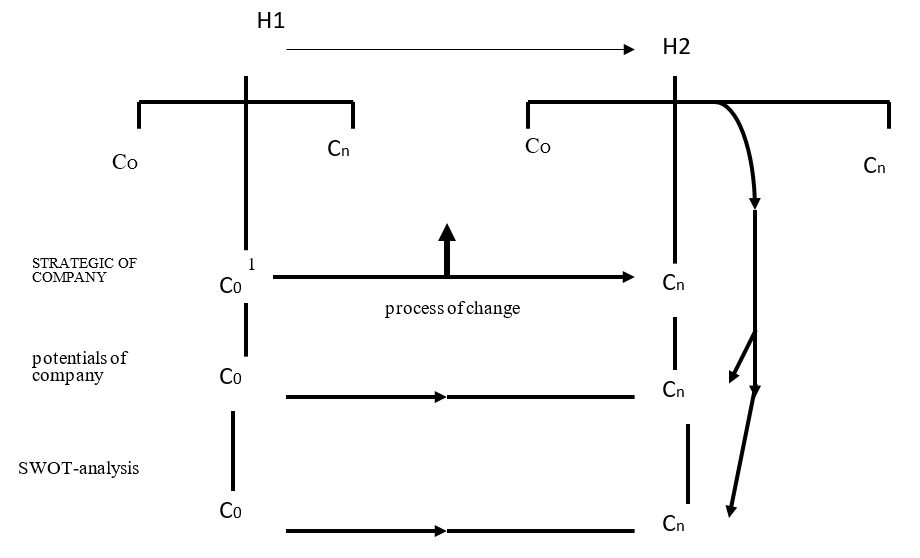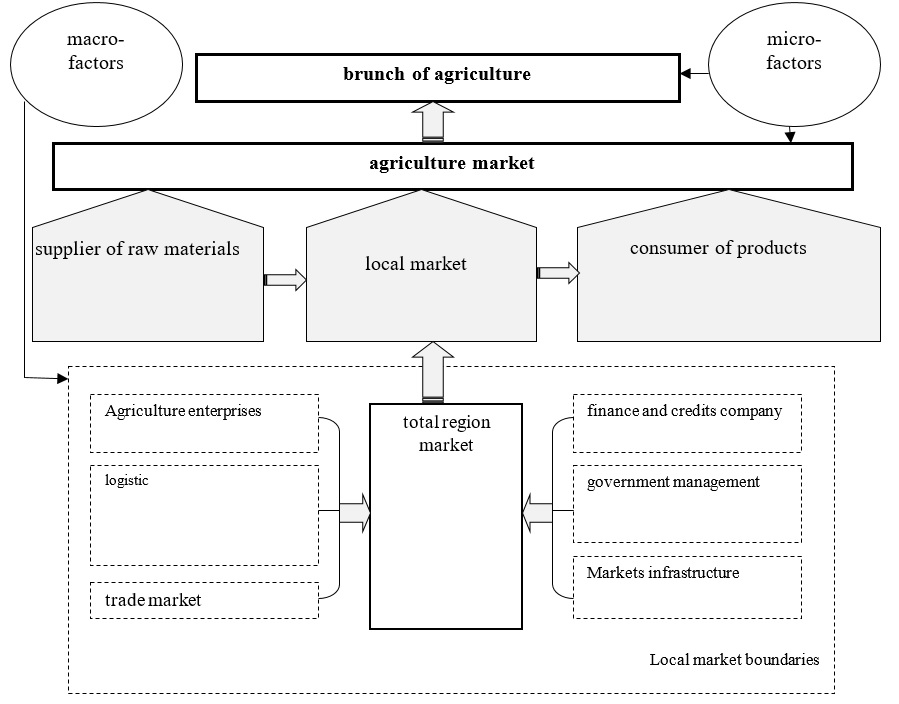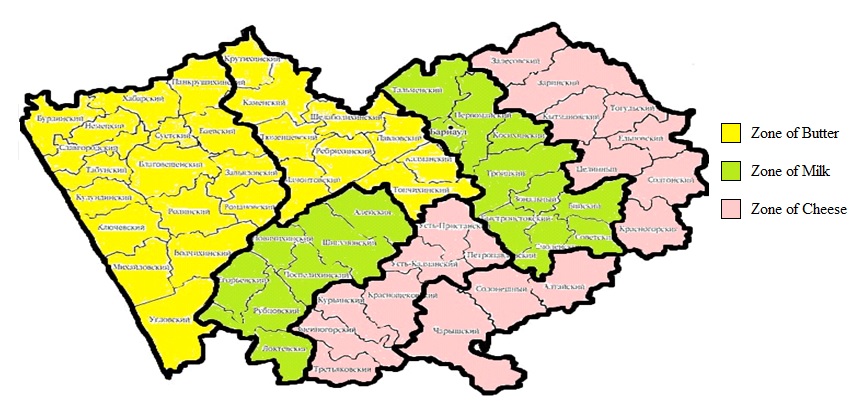Abstract
Assessment and development of commodity and raw material industrial markets of the agro-industrial complex requires the development of research methods based on the theory of local markets. This direction is relatively new in economic science. It is advisable to consider the localization of the sector product market as a reproduction system of an expanded type of local-territorial distribution of commodity flows and resources of the territory. Considering the functioning of the local market as an organizational and economic mechanism, one must get keen on explanation the particulars of the arrangement of the agricultural sector market, since a new segment stands out for the organic product market, which is formed by a complex of micro-markets that have their own development parameters in terms of factor elements. Considering the development and functioning of local sector markets, it be supposed to be borne in mind that the organizational and economic mechanism is a complex multifunctional system, including the production and sale of agricultural products, their processing, in a complex, forming separate local production markets.
Keywords: Methodological, approach, bioproduct, territorial-geographical, identification
Introduction
Considering the functioning of the local market as an organizational and economic mechanism, one must get keen on explanation the particulars of the arrangement of the agricultural sector market, since a new segment stands out for the organic product market, which is formed by a complex of micro-markets that have their own development parameters in terms of factor elements.
Problem Statement
Much attention is paid to the development of the market for organic and bioproducts in modern science, however, in Russian studies, the main attention is paid to the issues of agro-biotechnologies and the issues related to territorial production and reproduction of organic matter are not studied. In addition, attention should be paid to:
- development of local sectoral markets in the agrarian sector of the economy, since this sector of the regional economy is a strategic and system-forming element:
- strategic directions for the development of the bio products market in the region.
Research Questions
Studying the issues of territorial development of the sectoral sector of the economy involves determining:
- What strategic behaviour of companies in the market of products and services should be chosen?
- What segments should be identified in the industry market for agricultural products?
Purpose of the Study
The research of Development local market of conditions Competition.The basis research are the Methodology of brunch market in the Agriculture.
Research Methods
The methodological basis of this study was the works of domestic and foreign scientists-economists dedicated to the development of industry-specific product sub-complexes. The information base of the study was made up of statistical data from the Federal State Statistics Service, the Territorial Body of the Federal State Statistics Service for the Altai Territory, the Siberian Customs Administration. The study used the following methods: abstract logical, economic and statistical, monographic, as well as methods of system analysis, economic comparison, expert assessments, economic and mathematical modelling. The study of territorial production localization was carried out using the mapping method, which allows one to identify the development of mono-markets based on certain criteria. In the opinion of Ansoff (1991), even during the development of the strategy of strategic planning, it became clear that t the possibilities of the transition to new types of activities depend on the fact that the enterprise will be in state of success in them to function.
Findings
The Participant study is one of the significant components of market research. No company can consider itself marketing-oriented if it does not conduct a systematic (not from case to case, but constantly) and comprehensive (in all parameters and factors) study of its present and future, large and small, direct and indirect competitors .The study of competitors, the degree of rigidity of competition is the identification of the main competing firms in the market as a whole, in individual segments and regions, directly or indirectly competing with your enterprise, determining their strengths and weaknesses (in the organization of production and management), their own comparative advantages in the competition (in terms of price, quality, design, ease of use, etc.).
All this is combined into the concept of SWOT- analysis. Its tools underlie the study of competitors' research, systematization of the results obtained, and the development of an action plan to improve the position of the enterprise in the market. And it is important to do all this, if only because the analysis of competitors allows, first of all, to better understanding the system of needs and requests, desires and preferences of potential consumers.
The main question that needs to be answered is why consumers will give preference to your product, purchase products and services under your brand? In addition, it is necessary to find out what features of the product do consumers in this market segment pay attention to in the first place? What factors of competitiveness (most important) today? What changes in the product, in the methods of its promotion, in other components of marketing, in the management and organization of production, technology and technology should be carried out, in what sequence and in what time frame (Organic Farming Information System [OFIS], 2019). Normative legal acts regulating the competitive environment between enterprises: Federal Law of the Russian Federation dated July 26, 2006 No. 153-FZ "On Protection of Competition" (as amended), defines the organizational and legal framework for the protection of competition, including prevention and suppression authorities, state authorities of the constituent entities of the Russian Federation, local self-government bodies, other bodies or organizations performing the functions of these bodies, as well as state extra-budgetary funds, the Central Bank of the Russian Federation.
The objectives of this national rule are to ensure the agreement of the financial liberty free movement of goods, freedom of economic activity in the Russian Federation, protection of competition and creation of conditions for the effective functioning of commodity markets.
In accordance with the Federal Law, competition is rivalry among economic entities, in which the independent actions of each of them exclude or limit the ability of each of them to unilaterally influence the general conditions of flow of supplies in the pertinent product market. In turn, competition is closely related to competitiveness. However, the essence of the competitiveness of any economic entity (country, industry, firm, and product) is the same - it is the ability to outstrip a competitor in achieving the set economic goals and to receive certain benefits based on this.
The competitiveness of a country and an industry ultimately depends on the ability of a particular commodity producer to launch a competitive product on the market, that is, the ability to effectively carry out its economic activity in a market economy. The essence of the competitiveness of an enterprise (firm) does not cause disagreement among scientists and practitioners. It is defined as the ability to effectively carry out its economic activities in market conditions. Competitiveness is a widespread, everyday concept. However, its substantive essence did not find a generally accepted formal, and even more so quantitative, definition.
The main task of any enterprise is to achieve the competitiveness of the ability and reward stability. Therefore, in the course of strategic management, you are guided by goals and strategies for the development of an enterprise, about producing for new efficient forms and types of activities, as well as a harmonious combination. Tainting the interests of the company with the external environment. In the opinion of Ansoff (1991) and Kotler (2000), even during the development of the strategy of strategic planning, it became clear that t the possibilities of the transition to new types of activities depend on the fact that the enterprise will be in state of success in them to function.
But it is necessary to point out that a similar binding to the heated potential of the enterprise. It limits its ability to pursue strategic actions. Very often the enterprise did not manage to find for itself such a promising industry that it could be used in new to Н2 (Figure 1).

In the conditions of external instability of the H1 level, a number of strategies are possible, providing success: from C0 to Cn. If it is obvious from the examination of the factors of instability that in the future its level will increase (or to fall) to the point H2, the best for the enterprise of the strategy will be located between the point ¬mi C0 and Cn. Assessment and development of commodity and raw material industrial markets of the agro-industrial complex requires the development of research methods based on the theory of local markets.
Considering the functioning of the local market as an organizational and economic mechanism, one should take into explanation the details of the arrangement of the agricultural sector market, since a new segment stands out for the organic product market, which is formed by a complex of micro-markets that have their own development parameters in terms of factor elements (Organic Farming Information System [OFIS], 2019) in Figure 2.

To assess the territorial and geographical identification of local markets for the manufacture of natural foodstuffs and their changes in the context based on the results of the regression analysis of the economic efficiency of agricultural production, agricultural organizations of the Altai Territory are segmented into 3 cluster: I - far above the ground; II - average stage of manufacture; III - enterprise with a near to the ground of competence. For segmentation, the system of cluster study with a segment of 45 units was used (Table 1).
where: Y - gross milk yield, c; x1 - production cost, rubles; x2 - gross milk yield, c .; х3 - total costs, thousand rubles; х4 - labor costs, thousand people / hour; х5 - feed consumption, c.u .; х6 - average selling price, rubles; х7 - volume of proceeds, thousand rubles; х8 - profit / loss from product sales, 1 cent. rubles; х9 - marketability,% (Kotler, 2000).
The methods of economic and statistical analysis imply the study of key economic indicators of the development of the dairy market using methods of statistical data processing, methods of processing time series of statistical indicators in Figure 3 (Kovalev, 2017b; Kovaleva & Kovalev, 2016; Socio-economic indicators. Regions of Russia, 2018).

The formation and development of the market for bioproducts involves the development of public-private partnerships. A key feature of the algorithm is a predictive assessment of the socio-economic effect of the implementation of are private- government project (PGP) for the region (The world of organic agriculture [WOA], 2020).
It is proposed to make a predictive assessment of the socio-economic efficiency of the PGP- project for the region through an assessment of a number of indicators: the coefficient of compliance of the project with the priority areas of development of animal husbandry in the region, the coefficient of social efficiency of the plan the pointer of the monetary competence of the project.
Conclusion
Some theoretical and methodological aspects of strategy are researched. management, as well as models of choosing a strategic position in a competitive rental environment for Russian meat-processing enterprises, namely, it seems to be that in the current market conditions, in an unstable environment, the efficient functioning of the meat processing enterprise is impossible without strategic management in competitive environment Calculation of the expected socio-economic effect determination create it likely to create a choice on the expediency of financing the project with budgetary funds.
Thus, the considered conceptual and methodological approaches to assessing the development of local commodity markets for bioproducts on the basis of territorial and geographical identification and will optimize sector development and improve the good organization of administration decision (The world of organic agriculture [WOA], 2020). Considering the development and functioning of local sector markets, it be supposed to be borne in mind that the organizational and economic mechanism is a complex multifunctional system, including the production and sale of agricultural products, their processing, in a complex, forming separate local production markets. The local market is presented as a backbone link between consumers and manufacturers of PPK products, therefore, it is advisable to consider a trade link and a logistics infrastructure within the local market. state administration of the agro-industrial complex, the credit and financial sector and the processing unit (Research Institute of Organic Agriculture FiBL [FIBL st], 2021).
Thus, a systematic approach to considering the effective development of local markets for agro-industrial complex products will optimize the elements of strategic planning when justifying development prospects.
Acknowledgments
The article completed within the framework of the RFBR research project No. 19-510-44011 "Development of the concept of organic agriculture based on progressive methods and technologies".
References
Ansoff, H. I. (1991). Critique of Henry Mintzberg's ‘The design school: reconsidering the basic premises of strategic management’. Strategic management journal, 12(6), 449-461.
Kotler, F. (2000). Marketing and management. Millennium Edition. CopyrightPrentice-Hall, Inc.
Kovalev, A. (2017a). Development of the organizational and economic mechanism of the local market of the dairy-food subcomplex. Bulletin of the Altai State Agrarian University, 3(149), 183-188.
Kovalev, A. (2017b). On the theory of the development of local markets for the dairy subcomplex of the agro-industrial complex. Agricultural science for agriculture: collection of articles. articles of the XII International Scientific and Practical Conference, 218-220.
Kovaleva, I., & Kovalev, A. (2016). Development of integration processes in dairy cattle breeding. Successes of modern science, 3(11), 48-50.
Organic Farming Information System. (2019). List of recognised control bodies and control authorities for the purpose of equivalence. https://ioas.org/certification_bodies/organizacion-internacional-agropecuaria-s-a/
Research Institute of Organic Agriculture FiBL. (2021). Retrived from: https://statistics.fibl.org/
Socio-economic indicators. Regions of Russia. (2018). http://www.gks.ru/free_doc/doc_2018/region/soc-pok.rar
Tanygina, E. (2012). Formation of effective marketing strategy of subjects of meat and dairy subcomplex of regional. AIC Modern problems of science and education, 5. www.science-education.ru/105-7211
The world of organic agriculture. (2020). https://www.ifoam.bio
Copyright information

This work is licensed under a Creative Commons Attribution-NonCommercial-NoDerivatives 4.0 International License.
About this article
Publication Date
25 September 2021
Article Doi
eBook ISBN
978-1-80296-115-7
Publisher
European Publisher
Volume
116
Print ISBN (optional)
-
Edition Number
1st Edition
Pages
1-2895
Subjects
Economics, social trends, sustainability, modern society, behavioural sciences, education
Cite this article as:
Kovaleva, I. V. (2021). The Methodological Approach To Development Local Market Bioproducts Of Conditions Competition. In I. V. Kovalev, A. A. Voroshilova, & A. S. Budagov (Eds.), Economic and Social Trends for Sustainability of Modern Society (ICEST-II 2021), vol 116. European Proceedings of Social and Behavioural Sciences (pp. 2046-2052). European Publisher. https://doi.org/10.15405/epsbs.2021.09.02.230

